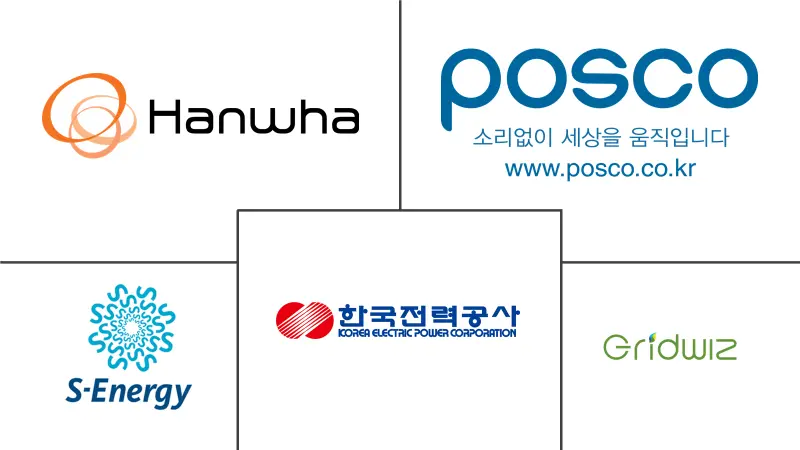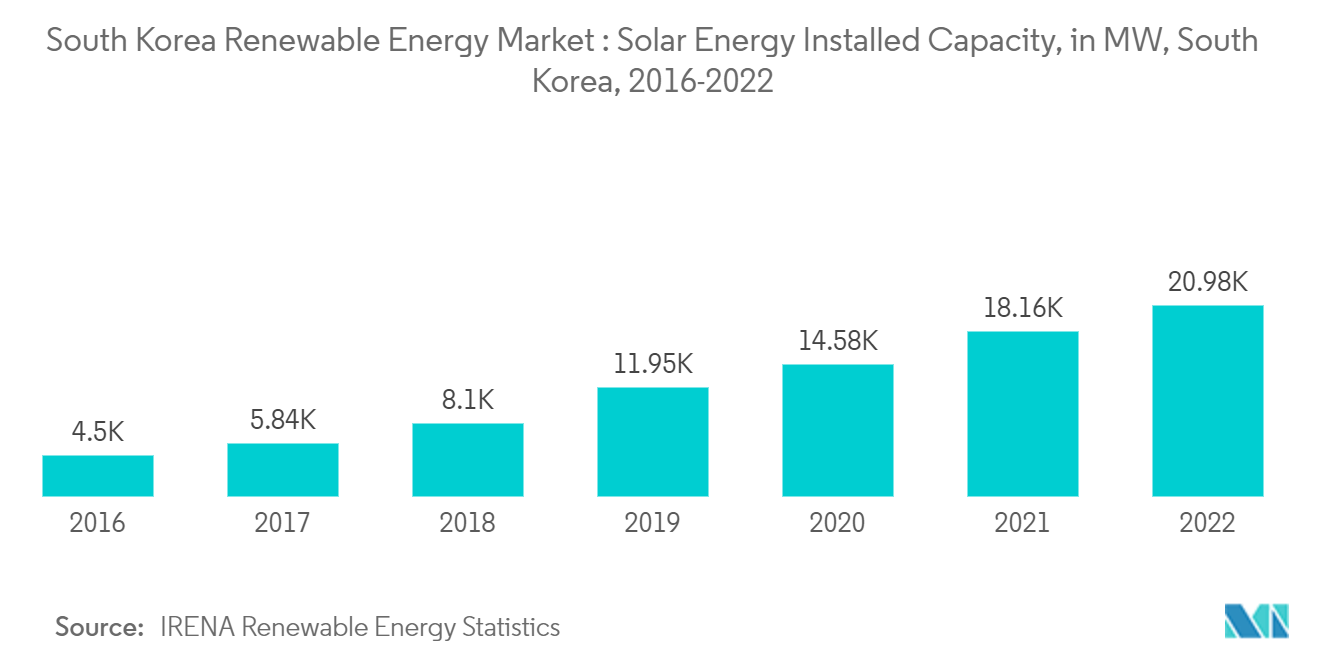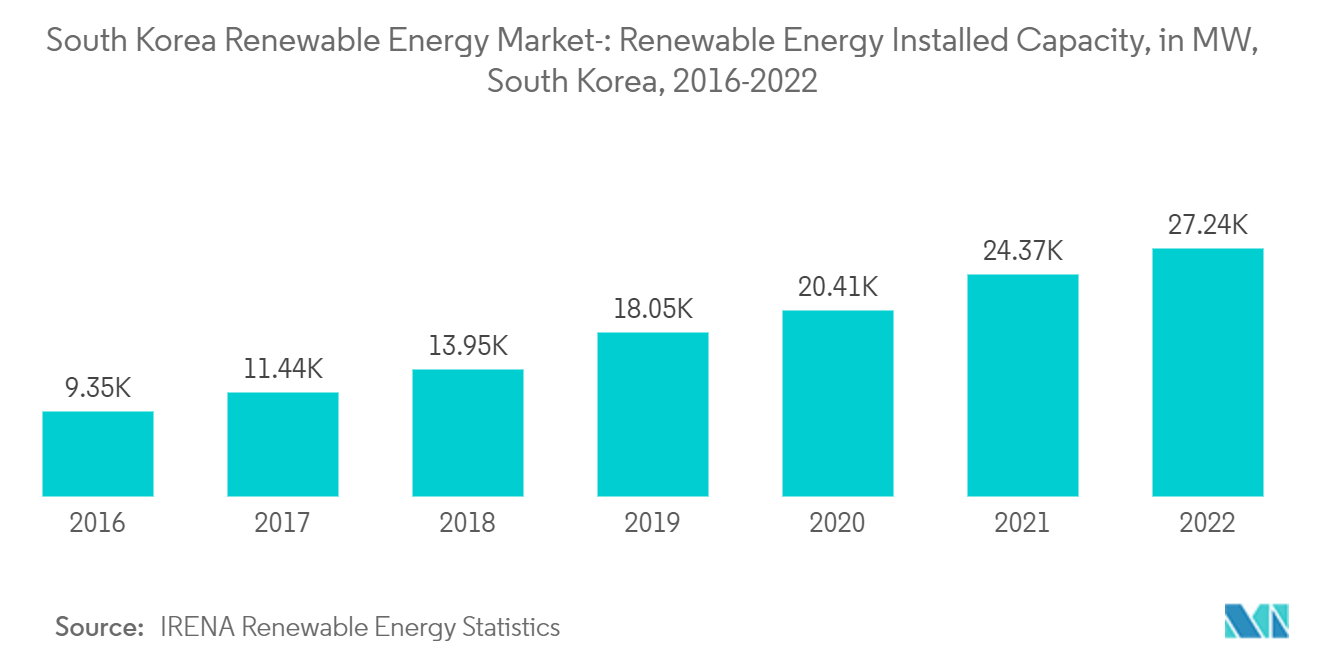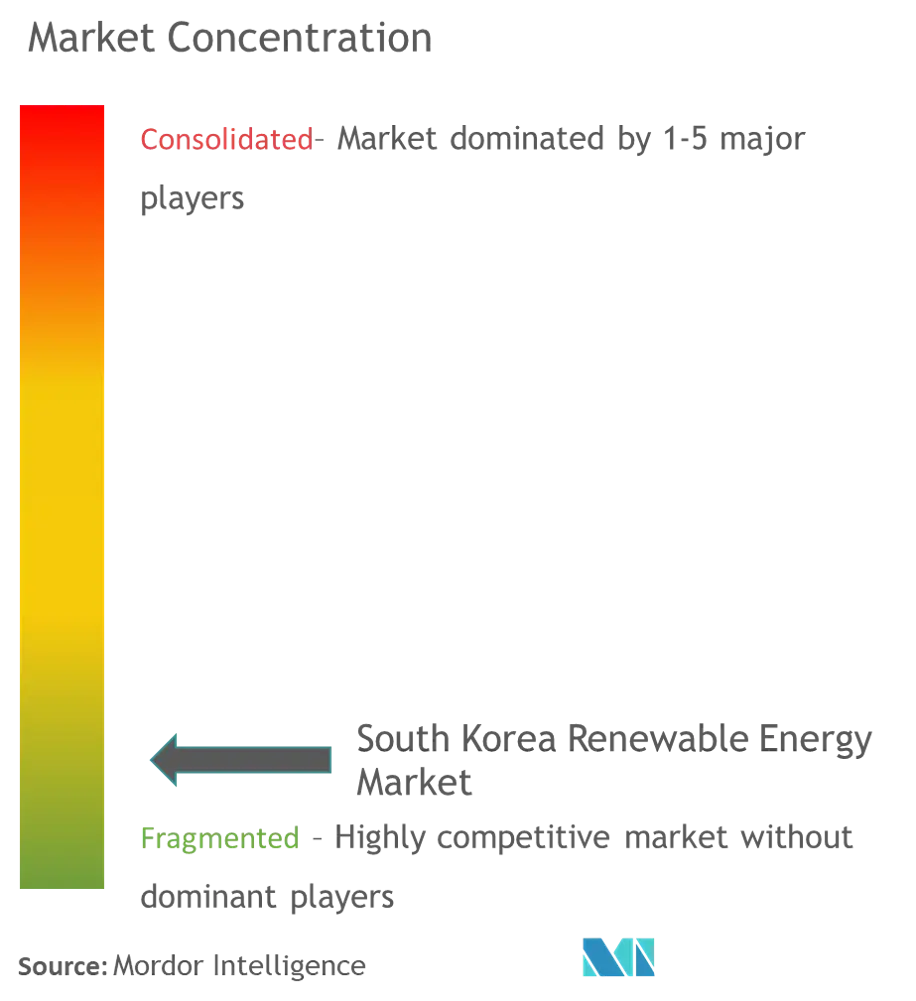South Korea Renewable Energy Market Size

| Study Period | 2019 - 2029 |
| Base Year For Estimation | 2023 |
| Forecast Data Period | 2024 - 2029 |
| Historical Data Period | 2019 - 2022 |
| CAGR | 5.50 % |
| Market Concentration | Medium |
Major Players
*Disclaimer: Major Players sorted in no particular order |
South Korea Renewable Energy Market Analysis
The South Korean renewable energy market is expected to register a CAGR of more than 5.5% during the forecast period.
- Over the medium term, factors such as reducing fossil fuel import dependence, rising environmental awareness, and the government's push to align with the Paris Climate Accords are expected to boost the demand for the South Korean renewable energy market during the forecast period.
- On the other hand, significant dependency on nuclear power is likely to restrain market growth.
- Nevertheless, the South Korean government is targeting an increase in the share of its renewable energy mix to 20% by 2030 and up to 42% by 2034. This is expected to present significant opportunities for the players involved in the market.
South Korea Renewable Energy Market Trends
Solar Energy Segment Expected to Witness Significant Growth
- As of 2022, the solar energy installed capacity in South Korea was 20.97 GW, significantly higher than the installed capacity in 2021, which stood at 18.16 GW, signaling rapid adoption of solar energy in the country.
- Despite facing issues regarding land availability, like Japan, the country has managed to reduce installation costs through the installation of utility-scale solar farms on reclaimed land, salt flats, and floating solar PV parks. According to IRENA, the weighted average installed cost of utility solar in South Korea stood at USD 940/kW, higher than most European and North American markets but significantly lower than Japan. For instance, in July 2022, construction began on a 200 MW solar farm at a former salt farm in Sinan, South Jeolla Province.
- In May 2022, two solar-power tenders were launched by the South Korean Energy Agency (a government agency) this year. The agency plans to distribute roughly 2 GW over 4 project types for the exercise: installations under 100 kW, projects with a capacity of 100-500 kW, PV arrays with a capacity of 500-3 MW, and solar plants with an installed power of more than 3 MW.
- Additionally, the country has a significant solar manufacturing sector, which is expected to reduce supply chain costs further. Additionally, the country is expected to relax solar permitting regulations to achieve its target of reducing emissions by 40% by 2030. For instance, in December 2022, SDN, a South Korean supplier of PV modules and marine propulsion systems, announced the construction of a new factory for solar modules in Gwangju, South Korea. According to the company, the factory will be able to produce 1 GW of solar panels utilizing tunnel oxide passivated contacts (TOPCon) technology, as well as modules featuring an unspecified tandem technology. As part of its plans to deploy two 500 MW production lines by 2025, the company plans to construct the factory building by the end of 2023.
- Thus, owing to the targets set by the government of South Korea and upcoming projects, solar energy is likely to witness significant growth during the forecast period.

Increasing Investments in Renewable Energy Sector Driving the Market Demand
- As a result of the lack of sufficient natural resources, South Korea relies heavily on imported energy sources to meet approximately 95% of its fossil fuel energy requirements due to its many highly energy-intensive industries. This has enabled Korea to maintain its position as one of the world's largest importers of energy commodities, including liquefied natural gas (LNG).
- The country has seen significant growth in renewable energy in recent years, largely due to favorable government policies and rising environmental concerns. The country also set up various targets related to CO2 emission reduction and renewable energy, driving the renewable energy market in the country.
- As of 2022, the installed capacity of renewable energy in South Korea was 27.24 GW, significantly higher than the installed capacity in 2020, which stood at 24.36 GW, signaling rapid adoption of renewable energy in the country.
- South Korea set a target of a 37 percent reduction in CO2 emissions by 2030 under the Paris Agreement of 2015. In order to meet the target, all the power plants were required to decrease CO2 emissions by 40% and 58% by 2022 and 2030, respectively.
- In February 2021, the South Korean government planned to invest around USD 43.2 billion in the construction of an 8.2 GW offshore wind project by 2030 in order to meet its goals for the renewable energy sector. When completed, this project is expected to rank among the largest single offshore developments in the world. The businesses have also committed to support the project with USD 42.4 billion. The remaining USD 802 million will be provided by the government.
- In December 2022, GE Renewable Energy and Hyundai Electric announced a strategic partnership agreement as the next step in their joint efforts to serve the South Korean offshore wind market. Hyundai Electric will serve as a manufacturing associate under the terms of the agreement in order to facilitate the localization of the assembly process of the Haliade-X offshore wind turbines and generators.
- Therefore, based on the abovementioned factors, increasing investments and upcoming projects in the renewable energy sector are expected to drive the South Korean renewable energy market during the forecast period.

South Korea Renewable Energy Industry Overview
The South Korean renewable energy market is partially fragmented. Some of the major players (in no particular order) include Hanwha Corp., Gridwiz Inc., Korea Electric Power Corporation, POSCO Energy Co. Ltd, and S-Energy Co. Ltd, among others.
South Korea Renewable Energy Market Leaders
-
Hanwha Corp
-
Korea Electric Power Corporation
-
POSCO Energy Co Ltd
-
S-Energy Co., Ltd
-
Gridwiz Inc.
*Disclaimer: Major Players sorted in no particular order

South Korea Renewable Energy Market News
- July 2022: SK D&D acquired 15 units of Siemens Gamesa's SG 5.0-145 wind turbines for South Korea's third-largest wind farm. As soon as it is completed in 2024, the Gunwi wind farm will produce enough electricity for 64,000 local households, forming part of the country's efforts to reduce reliance on fossil fuels and increase renewable energy generation to 20% by 2030.
- June 2022: The South Korean government announced a tender to contract 2 GW of solar PV capacity through the Korean New and Renewable Energy Center (KNREC). The country aims to select this capacity from four categories ranging from less than 100 kW to exceeding 3 MW. Projects using solar PV modules with a lower carbon footprint will be preferred.
South Korea Renewable Energy Market Report - Table of Contents
1. INTRODUCTION
- 1.1 Scope of the Study
- 1.2 Market Definition
- 1.3 Study Assumptions
2. RESEARCH METHODOLOGY
3. EXECUTIVE SUMMARY
4. MARKET OVERVIEW
- 4.1 Introduction
- 4.2 Renewable Energy Installed Capacity and Forecast, in MW, till 2028
- 4.3 Recent Trends and Developments
- 4.4 Government Policies and Regulations
-
4.5 Market Dynamics
- 4.5.1 Drivers
- 4.5.2 Restraints
- 4.6 Supply Chain Analysis
- 4.7 PESTLE ANALYSIS
5. MARKET SEGMENTATION
-
5.1 Type
- 5.1.1 Wind
- 5.1.2 Solar
- 5.1.3 Hydro
- 5.1.4 Other Types
6. COMPETITIVE LANDSCAPE
- 6.1 Mergers and Acquisitions, Joint Ventures, Collaborations, and Agreements
- 6.2 Strategies Adopted by Leading Players
-
6.3 Company Profiles
- 6.3.1 Korea Hydro and Nuclear Power Company Ltd.
- 6.3.2 S-Energy Co. Ltd.
- 6.3.3 Hanwha Corp.
- 6.3.4 Korea Electric Power Corporation
- 6.3.5 POSCO Energy Co. Ltd.
- 6.3.6 JinkoSolar Holding Co. Ltd.
- 6.3.7 Canadian Solar Inc.
- 6.3.8 Ocean Wind Energy Inc.
- 6.3.9 Engie SA
- 6.3.10 Gridwiz Inc.
- *List Not Exhaustive
7. MARKET OPPORTUNITIES AND FUTURE TRENDS
** Subject To AvailablitySouth Korea Renewable Energy Industry Segmentation
Renewable energy refers to energy sources that are replenished naturally and are therefore considered sustainable and environmentally friendly. Examples of renewable energy sources include solar, wind, hydropower, geothermal, and biomass. These sources of energy are considered renewable because they are replenished naturally and continuously, unlike non-renewable sources of energy such as fossil fuels (coal, oil, and gas), which are finite resources that will eventually be depleted.
South Korean renewable energy is segmented by type. By type, the market is segmented into hydro, wind, solar, and other types. For each segment, market sizing and forecasts have been done based on megawatts (MW).
| Type | Wind |
| Solar | |
| Hydro | |
| Other Types |
South Korea Renewable Energy Market Research FAQs
What is the current South Korea Renewable Energy Market size?
The South Korea Renewable Energy Market is projected to register a CAGR of greater than 5.5% during the forecast period (2024-2029)
Who are the key players in South Korea Renewable Energy Market?
Hanwha Corp, Korea Electric Power Corporation, POSCO Energy Co Ltd, S-Energy Co., Ltd and Gridwiz Inc. are the major companies operating in the South Korea Renewable Energy Market.
What years does this South Korea Renewable Energy Market cover?
The report covers the South Korea Renewable Energy Market historical market size for years: 2019, 2020, 2021, 2022 and 2023. The report also forecasts the South Korea Renewable Energy Market size for years: 2024, 2025, 2026, 2027, 2028 and 2029.
Renewable Energy in South Korea Industry Report
Statistics for the 2024 Renewable Energy in South Korea market share, size and revenue growth rate, created by Mordor Intelligence™ Industry Reports. Renewable Energy in South Korea analysis includes a market forecast outlook to 2029 and historical overview. Get a sample of this industry analysis as a free report PDF download.



